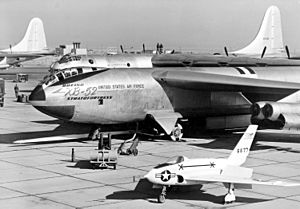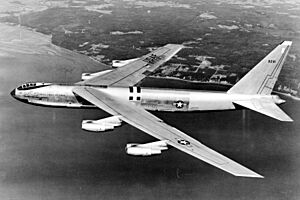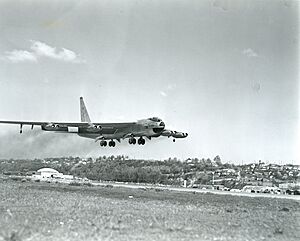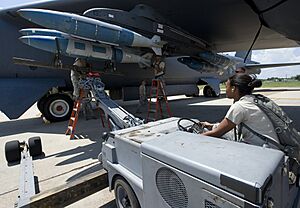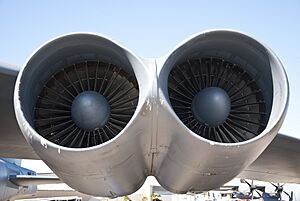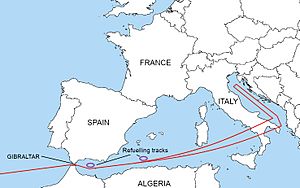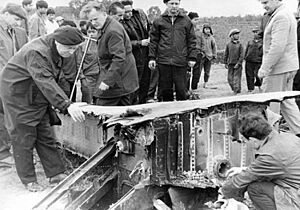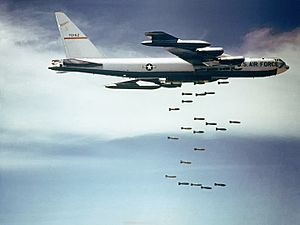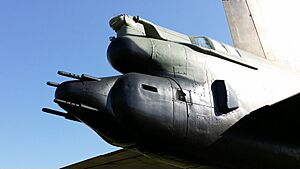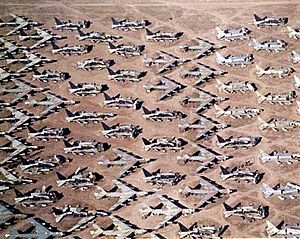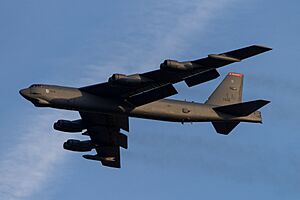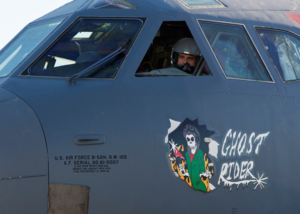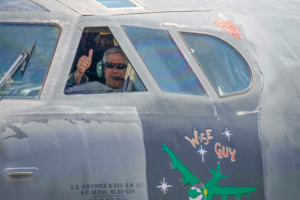Boeing B-52 Stratofortress facts for kids
Quick facts for kids B-52 Stratofortress |
|
|---|---|

A B-52H from Barksdale AFB flying over Texas
|
|
| General information | |
| Type | Strategic heavy bomber |
| National origin | United States |
| Manufacturer | Boeing |
| Primary users | United States Air Force
NASA (historical)
|
| Number built | 744 |
| History | |
| Manufactured | 1952–1962 |
| Introduction date | February 1955 |
| First flight | 15 April 1952 |
| In service | 1955–present |
The Boeing B-52 Stratofortress is a famous American long-range bomber aircraft. It's powered by jet engines and flies slower than the speed of sound. Boeing designed and built the B-52, and they still help keep it updated.
The United States Air Force (USAF) has used the B-52 since the 1950s. NASA also used it for almost 50 years. This powerful bomber can carry a huge amount of weapons, up to 70,000 pounds (32,000 kg). It can fly about 8,800 miles (14,200 km) without needing to refuel in the air.
The B-52 was first designed in 1946. Its design changed a lot, from a plane with six propeller engines to one with eight jet engines and swept wings. The first B-52 flew in April 1952. It started serving the USAF in 1955.
This bomber was built to carry nuclear weapons during the Cold War. It replaced an older bomber called the Convair B-36 Peacemaker. The B-52 has stayed in service for a long time because it performs well and isn't too expensive to operate. It has even outlasted newer, faster bombers. The B-52 has only dropped regular (conventional) bombs in real combat.
Today, there are 76 B-52s in the Air Force. Most are used by active forces, and some are with reserve forces. About 12 are stored in a special "boneyard" at Davis–Monthan Air Force Base. The B-52 has been flying for over 60 years. After getting upgrades, some B-52s are expected to fly until the 2050s!
Contents
Developing the B-52
How it Started
In 1945, the Air Force wanted a new bomber. It needed to fly long distances without relying on bases in other countries. The plane had to carry a crew of five or more, plus a relief crew. It also needed to fly at 300 miles per hour (480 km/h) at 34,000 feet (10,000 m) and carry 10,000 pounds (4,500 kg) of bombs.
Boeing won the contract in 1946 with their Model 462. This design had straight wings and six turboprop engines. But the Air Force soon worried it was too big and couldn't meet all the needs. Boeing then made a smaller, four-engine version.
Later, General Curtis LeMay wanted the bomber to fly even faster, at 400 miles per hour (640 km/h). Boeing kept changing the design. They were asked to make a four-engine bomber that could carry nuclear weapons and fly 12,000 miles (19,000 km).
By 1947, the Air Force realized the B-52 might be old-fashioned by the time it was ready. They almost canceled the project! But Boeing's president, William McPherson Allen, convinced them to keep going. He said the design could be updated with new technology.
Designing the Plane
In 1948, the Air Force asked Boeing to try jet engines. Jet engines used a lot of fuel back then, so they were hesitant. But Boeing engineers, including George S. Schairer, worked quickly. They redesigned the bomber in just a few days!
The new design, called 464-49, was like Boeing's B-47 Stratojet. It had swept wings and eight engines grouped in four pods under the wings. It also had special landing gear that could pivot. This helped the plane land safely in strong crosswinds.
Schairer even built a small model of the new design. The team worked hard on the plane's weight and performance. In April 1949, the Air Force liked the design. However, the jet engines still used too much fuel, making the range a problem.
General LeMay pushed for the design to continue. He didn't want delays because of engine problems. Finally, in February 1951, Boeing got a contract to build 13 B-52As. One big change LeMay insisted on was moving from a tandem (one behind the other) cockpit to a side-by-side cockpit. This made it easier for the pilots to work together.
The B-52's wings were designed to be very flexible. They could bend a lot during flight, which helped the plane handle strong winds and gave a smoother ride.
Building the B-52
During ground tests in 1951, the first prototype, the XB-52, was damaged. But the second one, the YB-52, flew successfully on April 15, 1952. The test flight lasted over two hours. The B-52's development was very thorough, with many hours spent testing. This made the flight tests go smoothly. The Air Force was so impressed they ordered 282 B-52s.
Only three B-52As were built, and they were used for testing. The first B-52s to be used by the Air Force were the B-52Bs. They started service in June 1955. Production lines were set up in Seattle and Wichita, Kansas. Over 5,000 companies helped build the B-52. Production of the B-52 ended in 1962, with 742 aircraft built, plus the two prototypes.
Upgrades and Changes
The B-52 has been updated many times over the years.
- Electronic Upgrades: In 2013, the Air Force started a big upgrade called CONECT. This modernized the B-52's electronics, communication, and computer systems. It helps the crew get updated information and target data during long flights.
- Weapon Upgrades: The B-52 also got the 1760 Internal Weapons Bay Upgrade (IWBU). This allows it to carry more smart bombs and missiles inside the plane. Carrying weapons internally reduces drag, which saves fuel.
- New Engines: The Air Force is planning to replace the B-52's engines with new, more efficient ones. This will make the B-52 fly further and use less fuel. These upgraded B-52s will be called B-52Js.
- Radar and Displays: The B-52 will also get a new, advanced radar system and updated cockpit displays.
How the B-52 is Designed
Overview

The B-52 shares some design ideas with the earlier B-47 bomber. Both have swept wings and jet engines in pods under the wings. The crew can eject from the plane in an emergency. In older B-52s, the tail gunner sat in the back. In newer models, the gunner moved to the front and used radar to aim.
Flying at low altitudes caused more wear and tear on the plane. So, the Air Force had programs to repair and strengthen the B-52s. The B-52 can fly very high, up to 50,000 feet (15,000 m). But for combat missions, it often flies around 43,000 feet (13,000 m) to save fuel and increase its range.
In 2006, the B-52 became one of the first US military planes to fly using alternative fuel. This was part of a plan to reduce the military's reliance on crude oil.
Flight Controls
The B-52 was designed for steady flight, not for quick, sharp turns. It has a small rudder and elevator for control. For big changes in pitch (nose up or down), it uses an all-moving tail. This is very important during takeoff and landing.
Instead of regular ailerons, the B-52 mainly uses spoilerons on its wings for rolling. This is because the wings are so flexible that ailerons would twist them too much.
Avionics (Electronics)
The B-52's electronic systems have been updated many times. The Jolly Well program improved its bombing and navigation computers. The MADREC system helped detect problems in the electronics.
To help fly at low altitudes, B-52s were fitted with the AN/ASQ-151 Electro-Optical Viewing System (EVS). This system uses a special camera for low light and an infrared system to see the terrain. Later, GPS was added for better navigation.
Since 2007, the B-52 can use the LITENING targeting pod. This pod helps the plane find and attack ground targets with precision-guided weapons. It uses lasers, infrared sensors, and a camera.
Weapons Carried
The B-52 can carry many types of weapons. In the 1970s, it was updated to carry up to 20 AGM-69 SRAM nuclear missiles. It also got air-launched cruise missiles (ALCMs), which are long-range missiles that can fly to a target on their own.
After the Cold War, the B-52 focused more on carrying conventional (non-nuclear) weapons. It was updated to carry a wide range of bombs and missiles, including Joint Direct Attack Munition (JDAM) guided bombs. These are "smart bombs" that can hit targets very accurately.
Moving these smart bombs from the wings to inside the bomb bay helps the B-52 save fuel. The B-52 can carry about 70,000 pounds (32,000 kg) of mixed weapons. It will also be able to carry new, advanced weapons like hypersonic missiles in the future.
Engines
The B-52 has eight engines, grouped in four pods under its wings. The first prototypes used experimental jet engines. Later models used different versions of Pratt & Whitney J57 turbojet engines. These engines used water injection to get extra thrust for short periods.
In 1961, the B-52H model started using Pratt & Whitney TF33 turbofan engines. These engines were quieter and used fuel more efficiently.
For many years, there have been talks about replacing the B-52's engines. In 2021, the Air Force chose the Rolls-Royce F130 engine for the upgrade. Unlike some earlier plans, this upgrade will keep all eight engines on the B-52. These upgraded planes will be called B-52Js.
B-52 in Action
Starting Service
The B-52B was the first version to be used by the Air Force. It began service in June 1955. Training for the crews involved ground school and many hours of flying. Early on, there were some problems, like fuel leaks and unreliable computers. The engines also had issues, causing the fleet to be grounded a few times.
In May 1956, a B-52B dropped the first air-dropped thermonuclear weapon during a test. In 1957, three B-52Bs flew non-stop around the world. This showed how far the B-52 could fly. Over the next few years, the B-52 set many speed and distance records.
The Cold War Era
During the Cold War, the B-52 was a key part of the US military's plan to deter the Soviet Union. B-52s often flew patrols near the Soviet Union's borders. This was to be ready for a quick strike or retaliation if a nuclear war started. This strategy was called Mutually Assured Destruction.
When new Soviet missiles could hit high-flying planes, the B-52's role changed. It was planned to fly at very low altitudes to avoid radar. This showed how flexible the B-52 design was. It could adapt to new types of warfare.
The B-52 received many upgrades during the Cold War. These included the ability to launch standoff nuclear missiles and advanced electronic systems to protect against enemy defenses.
Vietnam War Missions
B-52s were heavily used in the Vietnam War. In 1964, some B-52Fs were modified to carry more conventional bombs. The first combat mission, called Operation Arc Light, was flown in June 1965. Thirty B-52s bombed a communist stronghold. Two B-52s crashed during this mission due to a mid-air collision.
Later, many B-52Ds were modified to carry even more bombs. This allowed them to drop huge amounts of bombs in "carpet bombing" missions. These modified B-52Ds started flying from Guam in April 1966. They often needed to refuel in the air. Later, they flew from Thailand, which was closer.
B-52s were used in the Battle of Ia Drang in 1965. This was their first time supporting ground troops directly. The most famous B-52 attacks in Vietnam were during Operation Linebacker II in December 1972. B-52s flew hundreds of missions and dropped thousands of tons of bombs on targets in North Vietnam. During this operation, 15 B-52s were shot down by enemy missiles.
Air Combat Stories
During the Vietnam War, B-52 tail gunners were credited with shooting down two enemy MiG-21 fighter jets. On December 18, 1972, Staff Sergeant Samuel O. Turner, a tail gunner, fired his machine guns at a MiG-21. The MiG exploded, and Turner received a medal for his bravery. His B-52 is now on display with "kill markings."
On December 24, 1972, another B-52 tail gunner, Airman First Class Albert E. Moore, also shot down a MiG-21. Moore was the last bomber gunner to shoot down an enemy aircraft with machine guns in air combat. These victories make the B-52 the largest aircraft ever credited with air-to-air kills.
After Vietnam
Older B-52 models were retired in the 1960s and 1970s. However, the D models, which were used heavily in Vietnam, were kept longer. They received major overhauls to extend their life.
The remaining G and H models were used for nuclear alert duty. They were part of the United States' "nuclear triad" (bombers, land-based missiles, and submarine missiles). In 1991, B-52s stopped their continuous 24-hour alert duty.
After the Cold War ended, many B-52Gs were destroyed to follow the rules of the Strategic Arms Reduction Treaty. This was verified by Russia.
Gulf War and Beyond
B-52s played a big role in Operation Desert Storm in 1991. On January 16, 1991, B-52Gs flew from Louisiana, refueled in the air, bombed targets in Iraq, and returned home. This 35-hour, 14,000 miles (23,000 km) journey set a record for the longest combat mission at the time. B-52s dropped 40% of the weapons used by coalition forces in the Gulf War.
During this war, an Iraqi pilot claimed to have hit a B-52G. However, the US Air Force said the bomber was hit by friendly fire. After this, the tail gunner position on B-52s was removed.
Since the mid-1990s, the B-52H is the only version still in military service. It is based at Minot Air Force Base in North Dakota and Barksdale Air Force Base in Louisiana. One B-52H is used for flight testing, and another was used by NASA for research until 2008.
In 1996, two B-52Hs flew a 34-hour, 16,000 miles (26,000 km) mission from Guam to strike targets in Baghdad. This was the longest combat mission ever flown. B-52s also bombed targets in Yugoslavia in 1999.
The B-52 has been used in Afghanistan and Iraq. It can fly high above the battlefield and provide close air support using precision-guided bombs. It's very useful because it can stay in the air for a long time and deliver accurate weapons from a distance.
B-52 and Ocean Operations
The B-52 can also be used for ocean surveillance, anti-ship missions, and laying mines. For example, two B-52s can monitor a huge area of the ocean in just two hours. They have practiced laying mines off the coast of Sweden.
In the 1970s, some B-52Gs were modified to fire Harpoon anti-ship missiles. This helped protect US Navy aircraft carriers. Mines laid by B-52s could also block enemy ships.
Modern B-52Hs can use new radar systems to scan vast ocean areas. This helps them find and track ships.
21st Century Service
In 2007, there was an incident where a B-52 mistakenly carried nuclear warheads on some missiles. The weapons never left Air Force control and were secured.
Some B-52Hs that were stored in the "boneyard" have been brought back into service. In 2015, "Ghost Rider" became the first B-52 to return to service after six years in storage. Another, "Wise Guy," returned in 2019.
The Air Force plans to keep the B-52H in service until 2050. This would make it one of the longest-serving aircraft ever! The B-52 is still used because it's effective and affordable, especially against enemies without strong air defenses. It also has a very high "mission capable rate" compared to other bombers.
In 2015, B-52s started flying "freedom of navigation" operations in the South China Sea. They flew over areas claimed by China, refusing to leave. In 2016, a B-52 flew over South Korea after North Korea's supposed hydrogen bomb test.
B-52s have also been part of Operation Inherent Resolve against ISIL. They provide heavy bombing support. They also took part in the war in Afghanistan, providing close air support. In 2022, a B-52 was used to test a new hypersonic missile.
B-52 Models
The B-52 went through many changes during its 10 years of production.
- XB-52: Two prototype planes used for testing how the plane flew.
- YB-52: One XB-52 that was changed and used as a prototype.
- B-52A: Only three of these were built. They had a new front section with side-by-side seating for pilots and space for a sixth crew member. They also had a tail gun and external fuel tanks.
- NB-52A: One B-52A was changed to carry the North American X-15 experimental aircraft. It launched the X-15 on 93 flights.
- B-52B/RB-52B: The first version to enter service in 1955. Some could carry a reconnaissance (spy) pod.
- NB-52B: One B-52B was changed to launch the X-15 and later supported NASA research until 2004. It was nicknamed "Balls 8."
- B-52C: Had larger fuel tanks for more range and a new fire control system. The bottom was painted white to reflect heat from nuclear blasts.
- B-52D: A dedicated bomber without reconnaissance options. It was modified to carry huge loads of conventional bombs for the Vietnam War. These planes were painted camouflage with black bellies.
- B-52E: Received updated electronics and navigation systems.
- NB-52E: One B-52E was modified as a test plane. It was fitted with small "canards" (extra wings) near the nose to reduce airframe stress during low-level flight.
- B-52F: Had more powerful engines with a larger water injection system. It had problems with fuel leaks that were later fixed.
- B-52G: This version had new "wet" wings that held more fuel, increasing its range. The tail fin was shortened, and the tail gunner moved to the front of the plane. It was the most produced B-52 variant. Most were destroyed after the Cold War.
- B-52H: This is the only variant still in use today. It has quieter, more fuel-efficient turbofan engines. Its electronics were updated, and the tail gun was changed to a powerful 20mm cannon (later removed). The first B-52H flew in 1960.
- B-52J: This is the future upgrade of the B-52H, with new engines, radar, and communication systems. It should be ready before the end of the 2020s.
Who Uses the B-52
- United States Air Force (USAF)
- Air Combat Command
- Air Force Global Strike Command
- Air Force Materiel Command
- Air Force Reserve Command
- NASA (used historically for research)
Images for kids
-
Boeing B-52H static display with weapons, Barksdale Air Force Base 2006. A second B-52H can be seen in flight in the background
-
B-52G on static display at Langley Air Force Base in Hampton, Virginia
-
A B-52H Stratofortress of the 2nd Bomb Wing takes off from Andersen Air Force Base, Guam
See also
 In Spanish: Boeing B-52 Stratofortress para niños
In Spanish: Boeing B-52 Stratofortress para niños
- BRANE – airborne computer built by IBM for the B-52
- James Lore Murray
- Aircraft related to this one
- Conroy Virtus
- Similar aircraft
- V Force bombers:
- Convair YB-60
- Myasishchev M-4
- Tupolev Tu-95
- Lists related to this aircraft
- Accidents and incidents involving the B-52
- List of active United States military aircraft
- List of bomber aircraft
- List of military electronics of the United States


